A Heron, a Cormorant, and a Goose Family: Bird Life at Two Local Ponds
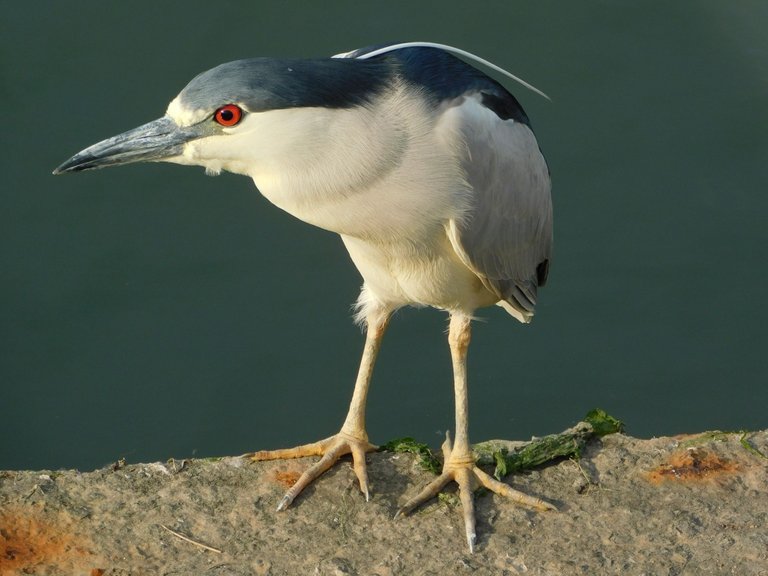
agmoore
My husband and I took a walk around two local ponds a week ago. We were amply rewarded, not only with fresh air, but with sightings of beautiful birds. One bird I did not recognize is featured above: the black-crowned night heron (Nycticorax nycticorax).
It took a while for me to find a description of this bird on websites discussing local birds (on Long Island, NY.) As I searched, it seemed the bird would end up being in the heron family, and sure enough it was.
The black-crowned night heron hunts in wetlands, mostly at night. It requires an "aquatic habitat for foraging and terrestrial vegetation for cover."
Reeds (Terrestrial Cover) at Mill Pond (My Photo)
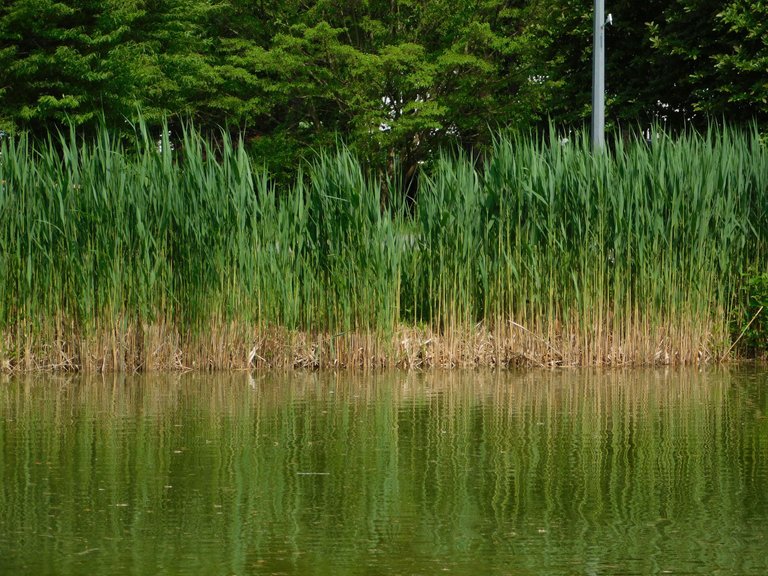
agmoore
A description of the black-crowned night heron from the Missouri Department of Conservation Field Guide
Black-crowned night-heron adult underparts and head are gray-white, the back and crown are black, and the wings gray. Bill is heavy and black; legs are yellow. Eyes are red.
A breeding adult will sprout whitish head plumes. I'm guessing this refers to the distinctive white strips extending from the bird's neck. The website Chesapeake Bay Program describes the 'plumes' this way:
Males have two long, white plumes on the back of their head during breeding season.
The bird I encountered is definitely an adult, breeding, black-crowned night heron. The adult female looks like the male, except she is a little smaller and apparently would not have the distinctive plumage.
Picture of a male black-crowned night heron from Wikimedia Commons:
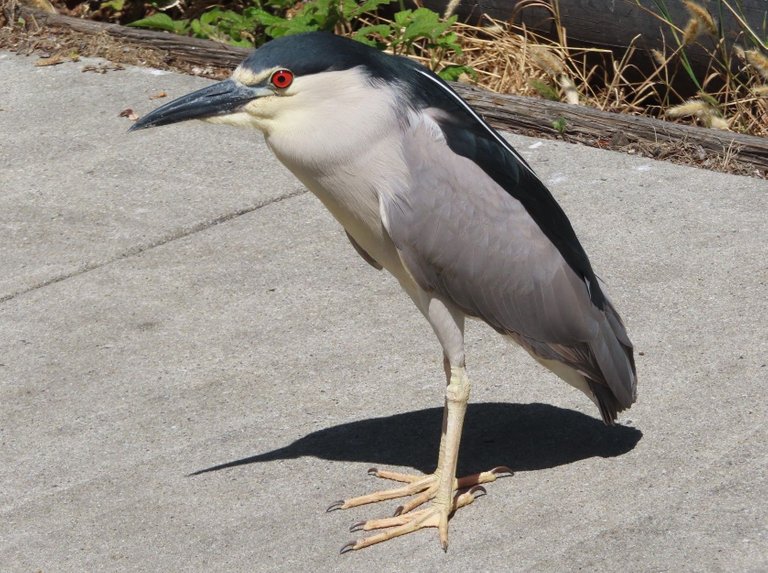
Credit: Pat Hansen. Used under Creative Commons Attribution-Share Alike 4.0 International license.
The bird is distributed across North America. It actually has global (every continent, except Antarctica) distribution and is the most common heron in the world.
Here is another picture of the heron (my picture from that day):
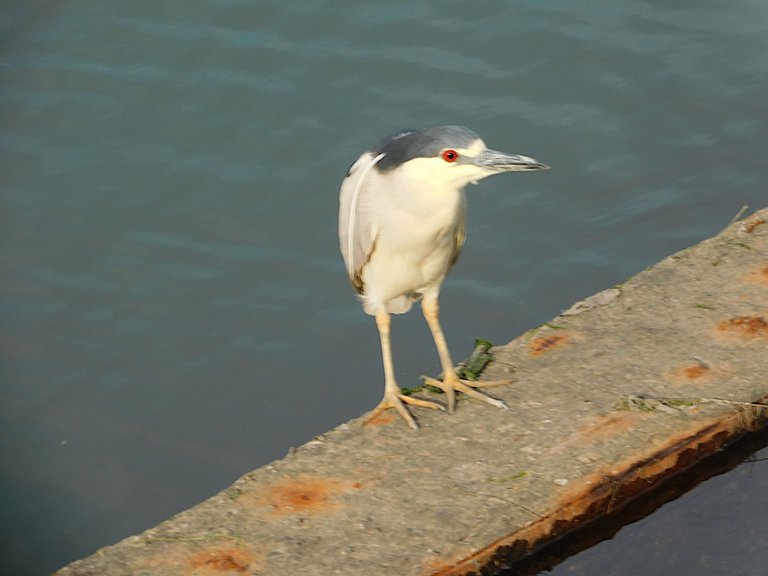
agmoore
These birds are cooperative nesters (male and female build together and both tend the young). Here is a Youtube video showing a mated pair building a nest together:
The pond where the bird was hunting (herons are serious hunters) is called Baxter's Pond. This pond and a neighboring pond, Mill Pond, are separated from Manhasset Bay by a narrow causeway.
Manhasset Bay, View From the West

Credit: Fred Hsu. Wikipedia User on en. Wikipedia. Used under Creative Commons 3.0 licensel.
My Shot of Manhasset Bay, View From the East (Across From the Ponds)
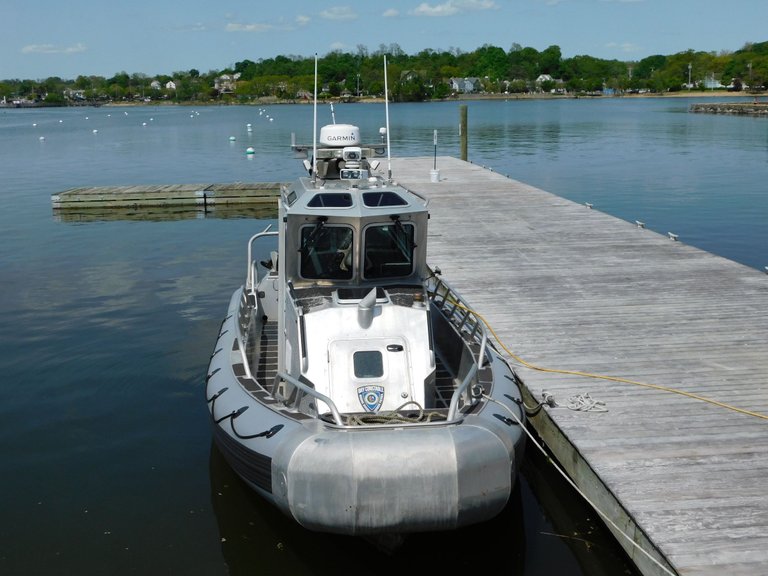
agmoore
I couldn't find a copyright free shot of Baxter's Pond, but Mill pond looks pretty much the same. The ponds are 0.3 miles apart.
Mill Pond
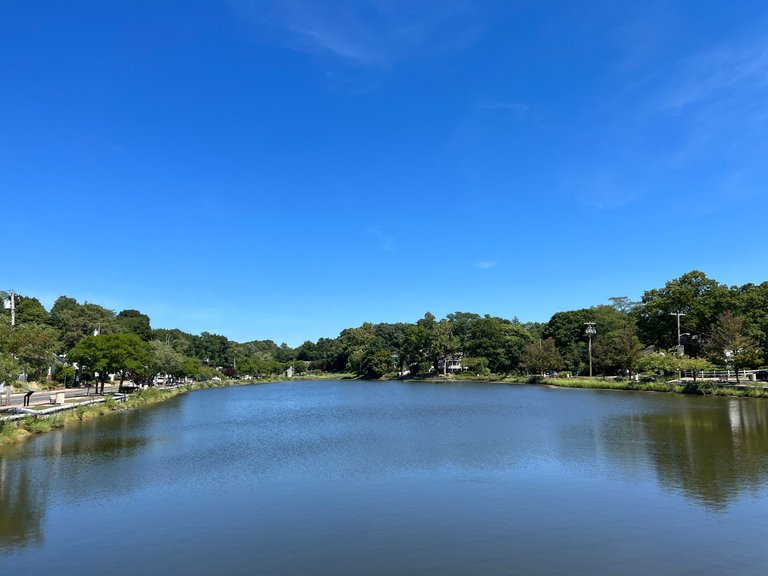
Credit: AITFFan1 Used under CC 4.0 license.
My Own Shot of Mill Pond (With Wading Birds)

agmoore
Both Mill Pond and Baxter's Pond were categorized as National Wetlands by the U. S. Interior's Department of Fish and Wildlife. As such, these ponds are magnets for, and support, a variety of wildlife.
Baxter's Pond: A Waterfall I Photographed That Day
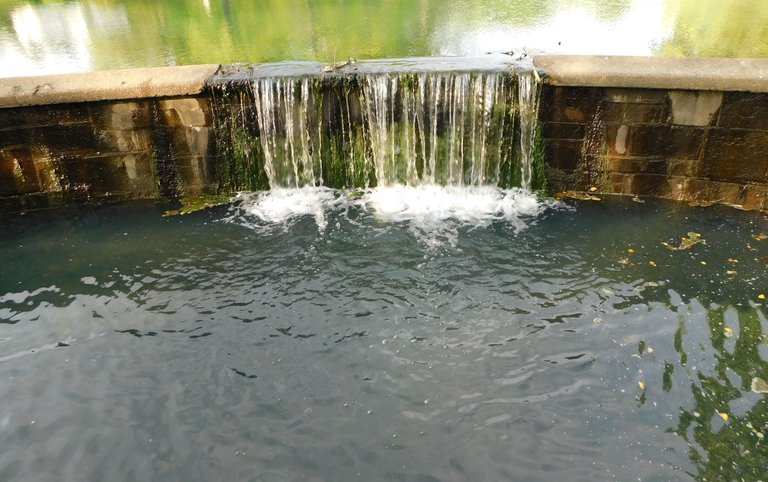
agmoore
I was trying to get close to the black bird you can see in my Mill Pond photo (a little further up in this post). This wasn't a bird I ordinarily see around local ponds. I couldn't get a good shot. The two photos shown below were the best photos I was able to manage without scaring the bird away:
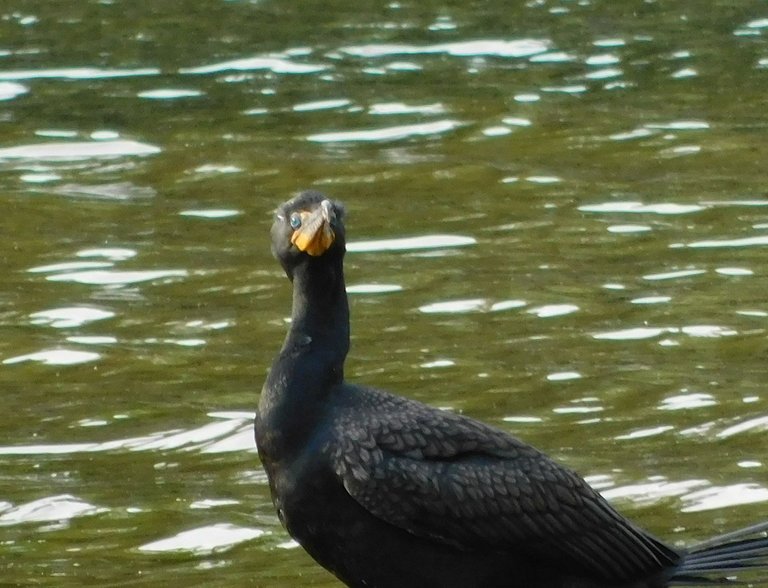
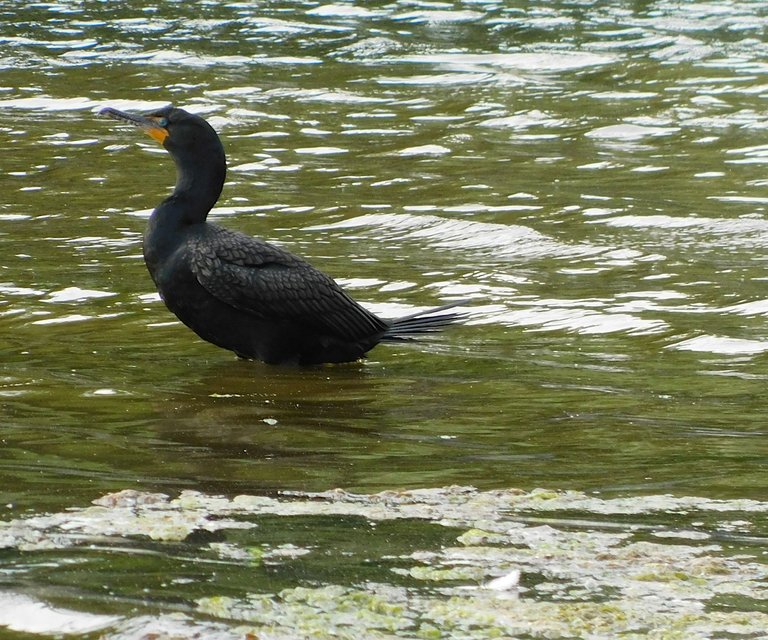
agmoore
A little research on bird websites yielded the information that the bird is apparently a double-crested cormorant (Phalacrocorax auritus), a non-breeding adult. A description of this bird, from the International Center for Wildlife Damage Mangement:
black plumage tinted with a greenish gloss on the head, neck, and underside, black bills are slender and cylindrical with a hooked tip and sharp edges, black, webbed feet set well back on their body, a long curving neck, orange facial skin, and an orange throat pouch.
Breeding adult males develop two crests during breeding season. Hence the name, double-crested cormorant. These birds are also cooperative nesters, with both mates building together. These cormorants nest in large colonies. Here is a Youtube video of a cormorant colony in New Jersey (USA)
Distribution is mostly in the U.S. with some in southern Canada and northern Mexico. They are migratory (not very long distances). Those that live in coastal Mexico do not migrate. They are adaptable, but favor aquatic habitats.
Here is a picture of the male double-crested cormorant, from Wikimedia Commons:
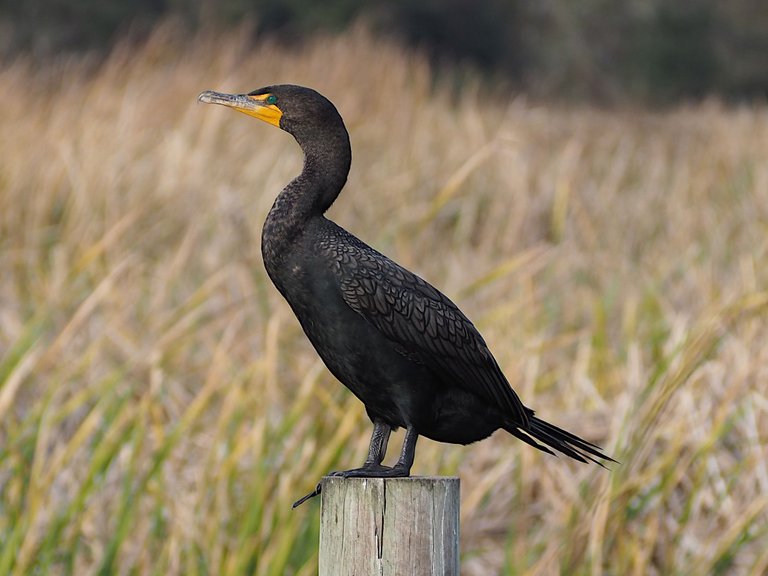
Credit: Zygy. Used under CC 1.0 license
There is a possibility that what I saw was a neotropic (Nannopterum brasilianum) cormorant. If I had been able to get a clearer picture the identification would be more certain. Here is a picture of the two types of cormorants next to each other. The double crested is supposed to have green eyes and the neotropic is supposed to have blue. Plus there is a dark patch under the eyes of netropics, and an orange patch under the eyes of the double crested. Can you tell which one of these I saw? The neotropic is rare in these parts, so that is also persuasive.
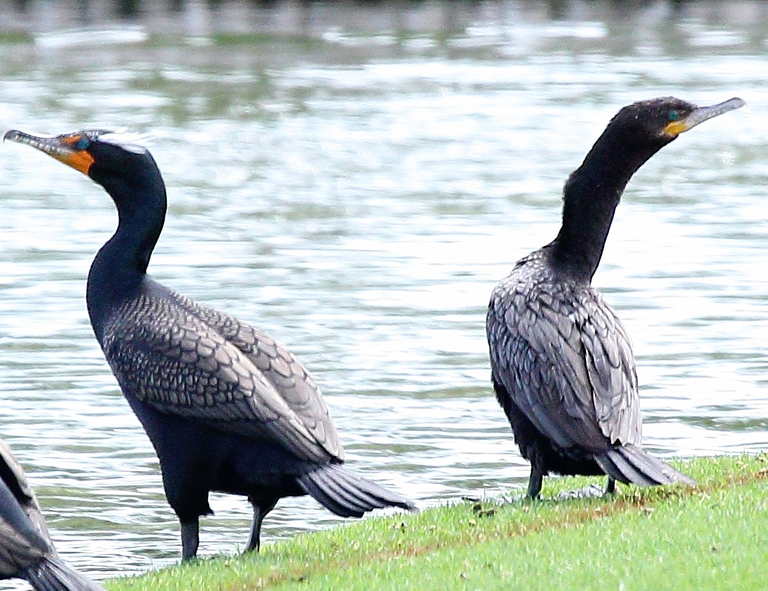
Credit: Dominic Sherony. Used under CC 2.0 license.
We didn't just see relatively exotic birds that day by the ponds. We also saw beautiful Canadian geese. They didn't pester us for food as has happened elsewhere. Here is a goose (at Mill Pond) that seemed interested in us, but didn't get too close. I was able to get a really clear shot of this bird.
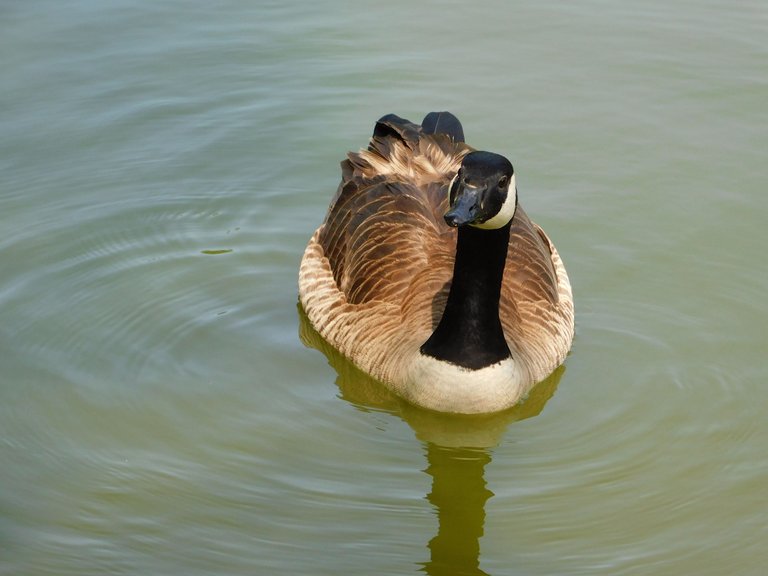
agmoore
We also saw geese (at Mill Pond) that were watchful as we approached (not close). This was a mated pair, with newly hatched goslings. Because I kept my distance the shot is not as clear as I would like it to be, but you can see the cute babies.
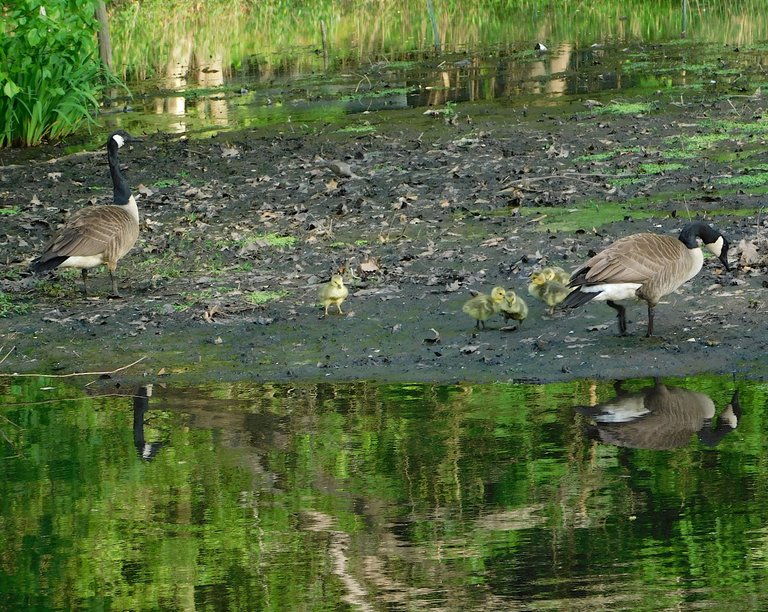
agmoore
Peak hatching season for geese in my area is late April to early May. Baby geese are born well formed (precocial) and leave the nest within 24 hours. Canada geese mate for life and only separate if one dies. Then the surviving goose will look for another mate.
Canada geese are quite common in my area (and are even considered pests by some people). They may migrate as far North as Alaska and the Aleutian Islands, and as far South as northern Mexico. However, there are actually Canada geese in Canada, also. Here's a picture of a goose snapped by my friend @redheadpei, in Canada.
Geese that live year round (not migratory) are called resident geese.
Canadian Goose That Lives in Canada
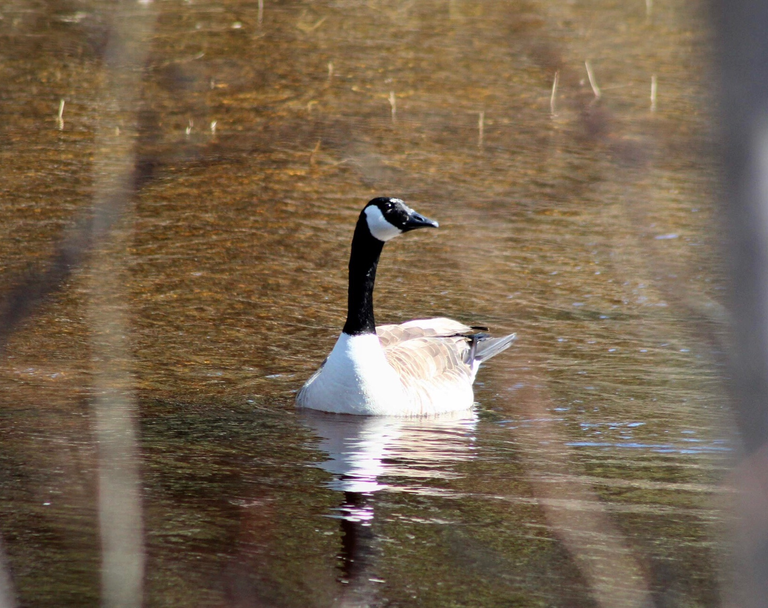
Credit: @redheadpei, on the LMAC Image Gallery LIL.
Used under a public Domain license.
Conclusion
It was a pleasure to share my pictures and experience at these local ponds. I have shown the highlights. There was so much more, much of it out of sight. You can see ripples in the water where life goes on in minute forms. In this last photo, for instance, I show the waterfall at Baxter's Pond and have circled a few places where fish were evident just below the surface. The fish are circle in grey (and sadly, a bit of trash circled in red).
Waterfall at Baxter's Pond
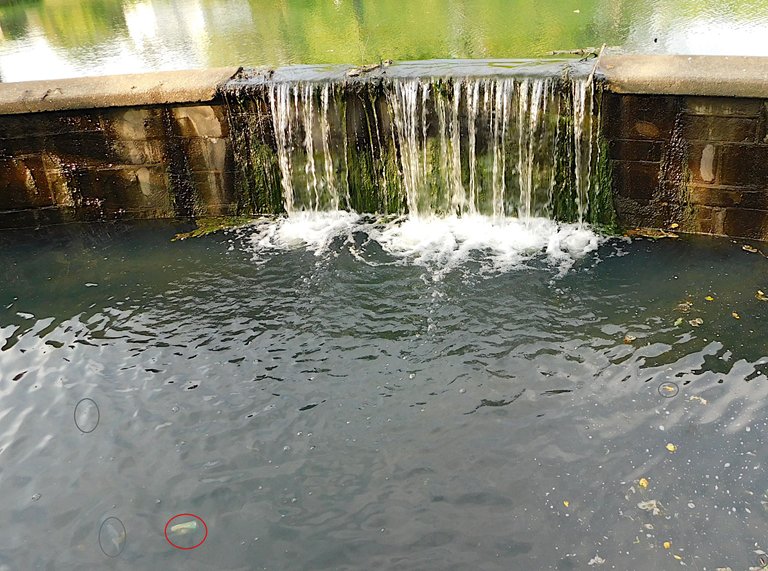
agmoore
I hope you have enjoyed this excursion around two local ponds in my area. A parting photo of a goose chick (extracted from my larger photo above).
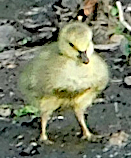
https://www.allaboutbirds.org/guide/Black-crowned_Night-Heron/lifehistory
https://mdc.mo.gov/discover-nature/field-guide/black-crowned-night-heron
https://www.chesapeakebay.net/discover/field-guide/entry/black-crowned-night-heron
https://nhpbs.org/natureworks/blackcrown.htm
https://nationalzoo.si.edu/migratory-birds/species-profile-black-crowned-night-heron#:~:text=They%20are%20widespread%20throughout%20North,continent%20except%20Australia%20and%20Antarctica
https://animallist.weebly.com/black-crowned-night-heron.html
https://manhassetbayprotectioncommittee.org/uses__ecological_importance.htm
https://icwdm.org/species/birds/cormorants/
https://www.allaboutbirds.org/guide/Double-crested_Cormorant/lifehistory
https://www.audubon.org/field-guide/bird/double-crested-cormorant
https://badgerlandbirding.com/2020/05/23/double-crested-cormorant-vs-neotropic-cormorant/
https://www.dec.ny.gov/animals/34434.html
https://birdfact.com/articles/baby-geese
https://www.allaboutbirds.org/guide/Canada_Goose/maps-range
https://dnr.maryland.gov/wildlife/Pages/plants_wildlife/ResGeeseProblem.aspx
What beautiful birds, the photo of newly hatched goslings melted me, they all look so beautiful as a family.
I am happy that there are these places where birds can live peacefully without being disturbed
Hello @malos10. Thank you for stopping by. Yes, the baby geese were lovely, and I am happy there is a refuge for the wildlife. It's a privilege for us to share the space with them.
I hope you have had a lovely Sunday :)
What a lovely walk, A.G. @agmoore, and neat waterfall.
Lots of cormorants in Charlottetown nesting on the former old bridge posts on the Hillsboro River and the last few years I’ve seen more coming into the Montague River. I think they are the double crested ones and not the Great Cormorant.
Thanks for using my image of the Canada Goose. I know they are often discriminated against because they can leave mass amounts of feces when a flock decides to take up residence. 😆
Have a great week ahead, my friend, 😊
Hello my friend, @redheadpei . I loved your goose. I figured there had to be a real Canada goose in this blog😁
It was a lovely walk. We're lucky that such a beautiful place is close to our home. I know you have spectacular scenery where you live, also, probably better than mine, with all the little critters around.
As I get older, the sea draws me. I really do want to live near the sea.
As for those messy geese--I know, but I love them. I just walk around the poo. Maybe I wouldn't feel that way if they nested in my yard!
Thanks for your lovely comment. Hope you are well and have had a lovely Sunday.
Amazing highlights, @agmoore.
You and your husband had a great time visiting the local pond and you brought us beautiful and exciting pictures of birds. 😍
Thank you so much for sharing with us and taking the time to add the details of each bird especially how one can easily recognize them using their features.
Hello @iskawrites,
Thank you for reading and commenting.
Yes, we did have a lovely afternoon. It was fun sharing these images. When they are appreciated, it's even more fun🌺
My pleasure ❣️
And I am glad to know that 😍
Truly, I am in support 🤝
Only thing better than birdwatching would be birdpetting and birdkissing. But I guess that unnatural stuff only happens in Christian heaven!
😅
I've actually seen someone do this (to a pet!)
Thanks for your contribution to the STEMsocial community. Feel free to join us on discord to get to know the rest of us!
Please consider delegating to the @stemsocial account (85% of the curation rewards are returned).
Thanks for including @stemsocial as a beneficiary, which gives you stronger support.
Thank you @stemsocial for your support. It is much appreciated.
Hello @agmoore,
Pleasure to be here again, this is my second bird specie I’m learning from you. I must say your walk and explorations tend to yield fun results like how you came across these creatures and in the end we all came to learn about them.
This is my first time seeing these though, I dunno if perhaps I have seen some in movies, well I wouldn’t even recall but they definitely ain’t here in Ghana.
Anyway so I loved that you took us along your journey and I’m glad I got to be here once again, thank you so much for sharing and do extend my regards to your husband for me.
I hope you were wearing your lenses during these exploration though😂😂
Hello @nattybongo,
Thank you for visiting and for your lovely comment. I wear my glasses, every day🙂
The animals are so beautiful, aren't they? We are all a part of the same cycle of life and there is something calming about remembering that.
Thank you for the regards. I wish for you and your family a most peaceful, healthful day.
Regards, AG
They are indeed beautiful, and it is good that we remind ourselves about the cycle of life every now and then, it teaches us humility.
Thanks for the well wishes Ma’am, it’s a pleasure